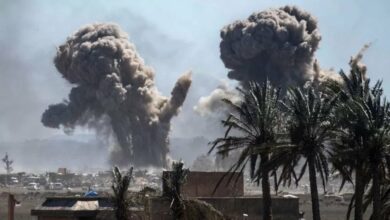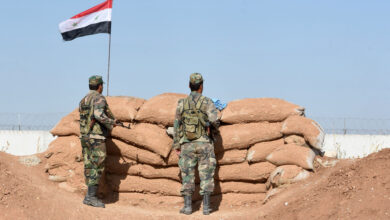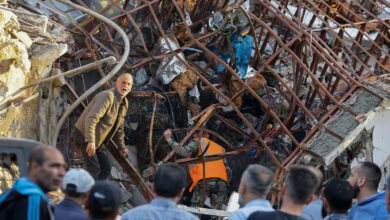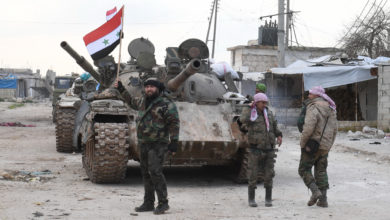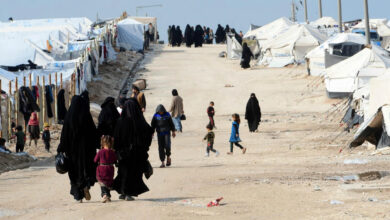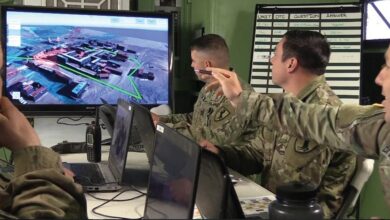“At least one Syrian soldier killed in coalition strike: monitor”
That’s the headline of an AFP story about a Thursday, June 21 incident in the 55 km deconfliction zone controlled by the vetted Syrian opposition group Jaysh Maghawir al-Thawra (MaT) backed by Coalition forces in southern Syria.
According to the story’s lead paragraph, the U.K.-based Syrian Observatory for Human Rights said seven “others” were wounded in a U.S.-led Coalition “strike.”
“There was a vehicle moving around that gathering point, which lies just 20 kilometres away from Al-Tanf,” the Observatory’s director Rami Abdel Rahman told AFP.
“The vehicle and the position were both targeted,” he told AFP.
The AFP story – now in its sixth version – does not say whether the alleged “strike” was carried out by an aircraft or artillery, but the corresponding post on SOHR’s website referred to aircraft.
However, that post has since been deleted, replaced by a different post, which says that “the Syrian Observatory for Human Rights learned that the International Coalition’s warplanes targeted a position of the regime forces and a vehicle, in the area of Halbeh in the south-eastern desert of Palmyra.”
Pentagon and Coalition comment
We at The Defense Post aim never to publish a story based on a single source, and we contacted the Coalition for comment.
Meanwhile, AFP sought comment from those involved in the incident. Around an hour after first publishing the story, they added quotes from Pentagon spokesperson Major Adrian Rankine-Galloway:
“The Pentagon denied any strike had occurred and that while there was a brief clash, there had been no casualties.
Pentagon spokesman Major Adrian Rankine-Galloway told AFP that fighters from the U.S.-backed Syrian rebel group Maghawir al-Thawra and Coalition advisors ‘within the de-confliction zone near al-Tanaf were engaged by an unidentified hostile force located just outside the de-confliction zone.’
The U.S.-backed rebels and coalition advisors ‘returned fire in self-defence, at which time the hostile force disengage,’ Rankine-Galloway said.”
The Coalition did not respond to our request for comment until Friday afternoon.
A spokesperson told me:
“Maghawir al-Thowra fighters and Coalition advisors within the deconfliction zone near At Tanf were engaged by an unidentified hostile force located just outside the deconfliction zone in the early evening June 21.
“MaT fighters and their Coalition advisors attempted to break contact under continued fire, and returned fire in self-defense, at which time the hostile force disengaged.
“There were no Coalition or partner casualties. Coalition officials are engaged with Russian counterparts on the deconfliction line to ensure no miscalculations.”
We had asked if the Coalition had conducted an airstrike, and, while not specifically addressing this question, the Coalition response appears to describe a minor ground engagement.
This version of events is supported by information published on Thursday by Hammurabi’s Justice News, a social media-based outlet closely connected to MaT.
“Exclusive for HJN: While conducting counter ISIS patrols in the northern DCZ, near Al-Tanf. Magaweer Al- Thowra and US forces were fired on with heavy effective fire.
“In an act of self-defense, Magaweer Al-Thowra and US forces returned fire using deadly force. There were no Magaweer Al-Thowra or U.S. casualties from this exchange.
“Let it be known that the commandos of the revolution stand in the face of danger in order to protect the good people of the 55km.”
HJN’s tweet was retweeted by MaT’s account.
An unconfirmed video purported to be of Thursday’s event was also tweeted from a pro-opposition account late on Thursday.
The video shows a group of vehicles, mainly the technicals typically used by the Syrian opposition. It also shows at least two U.S.-made M-ATV vehicles, commonly used by U.S. forces in Syria.
SE. #Syria: footage purportedly showing today clashes between Regime & #FSA Maghaweer Thawra near Olayniah, in Al-Tanf zone. pic.twitter.com/IBDLAjrJ14
— Qalaat Al Mudiq (@QalaatAlMudiq) June 21, 2018
There is no evidence of aircraft, but the sound of gunfire is clearly audible throughout the one-minute clip.
Reuters cites a single pro-Assad source
Reuters also reported the incident.
“U.S. bombs Syrian army position near Tanf: pro-Assad commander” reads its headline.
The lead paragraph – “A Syrian army officer was killed in a U.S strike on a Syrian army outpost near a U.S. base close to the Iraqi-Syrian border, a commander in the regional alliance supporting President Bashar al-Assad told Reuters.” – plus two sentences on the Pentagon denial is the sum total of information that bastion of reporting gives us.
(Un)reliable sources?
So, where does all this leave us?
AFP reports that there was an airstrike, and that Syrians were killed and injured, citing SOHR, which doesn’t identify its source(s); Reuters reports a Syrian soldier killed, citing a pro-Assad commander.
That’s the sum total of information, aside from the Pentagon and Coalition. Just two sources, both unknown.
Should we consider AFP’s SOHR and Reuters’ pro-Assad commander as of equal value and reliability?
Taken together, these stories leave a few possibilities. Maybe SOHR and the pro-Assad commander got it wrong or are lying? Maybe the Pentagon and Coalition are being economical with the truth? Maybe an unknown third party (Israel? Russia?) bombed the Syrian army outpost?
It’s not my role to cast judgement on the validity or otherwise of these stories.
However, I have been trying to report on Syria for several years, and my view that SOHR is not a reliable source for information has not altered since some time in early 2017, after investigating a number of reports the Observatory made and finding little to support them.
Later in 2017, in the middle of a long and sometimes tetchy exchange about a still-controversial Coalition airstrike on a school in Mansoura near Raqqa that may have resulted in civilian casualties, I asked the Coalition for comment. A spokesperson told me:
“Most of our critics do not conduct such detailed assessments and often rely on scant information, which frequently comes from single unreliable sources.”
“The media has already vetted the Syrian Observatory for Human Rights and it has been found wanting. Still their claims are printed as fact and rarely questioned.”
“The Coalition encourages all serious media outlets to not amplify or make salacious claims about civilian casualties without vetting their sources. We believe that endorsing unverified claims by these groups is not in keeping with the highest standards of journalism.”
I agree with them.
And that’s why The Defense Post may post stories hours or days late, or even miss them entirely. We strive for confirmation – or multiple sources at the very least – before publication.



